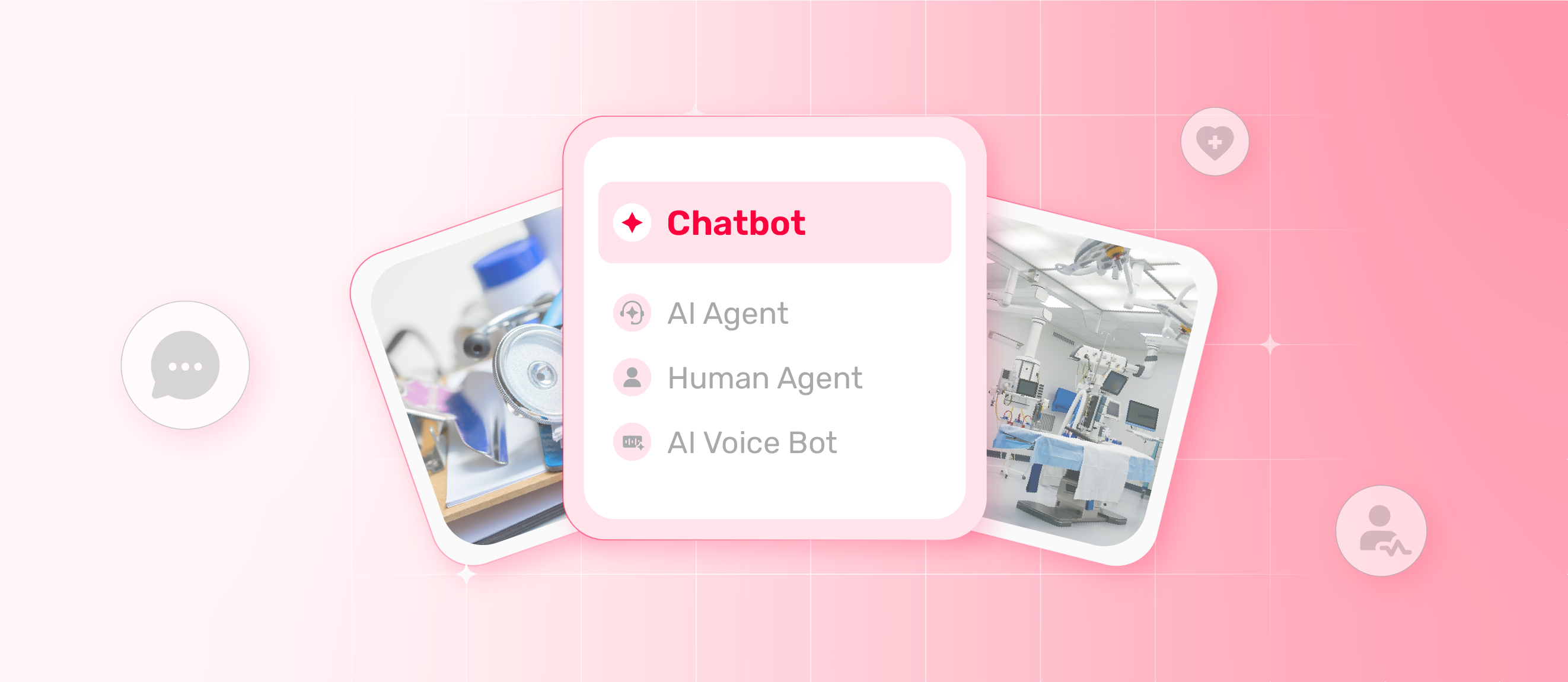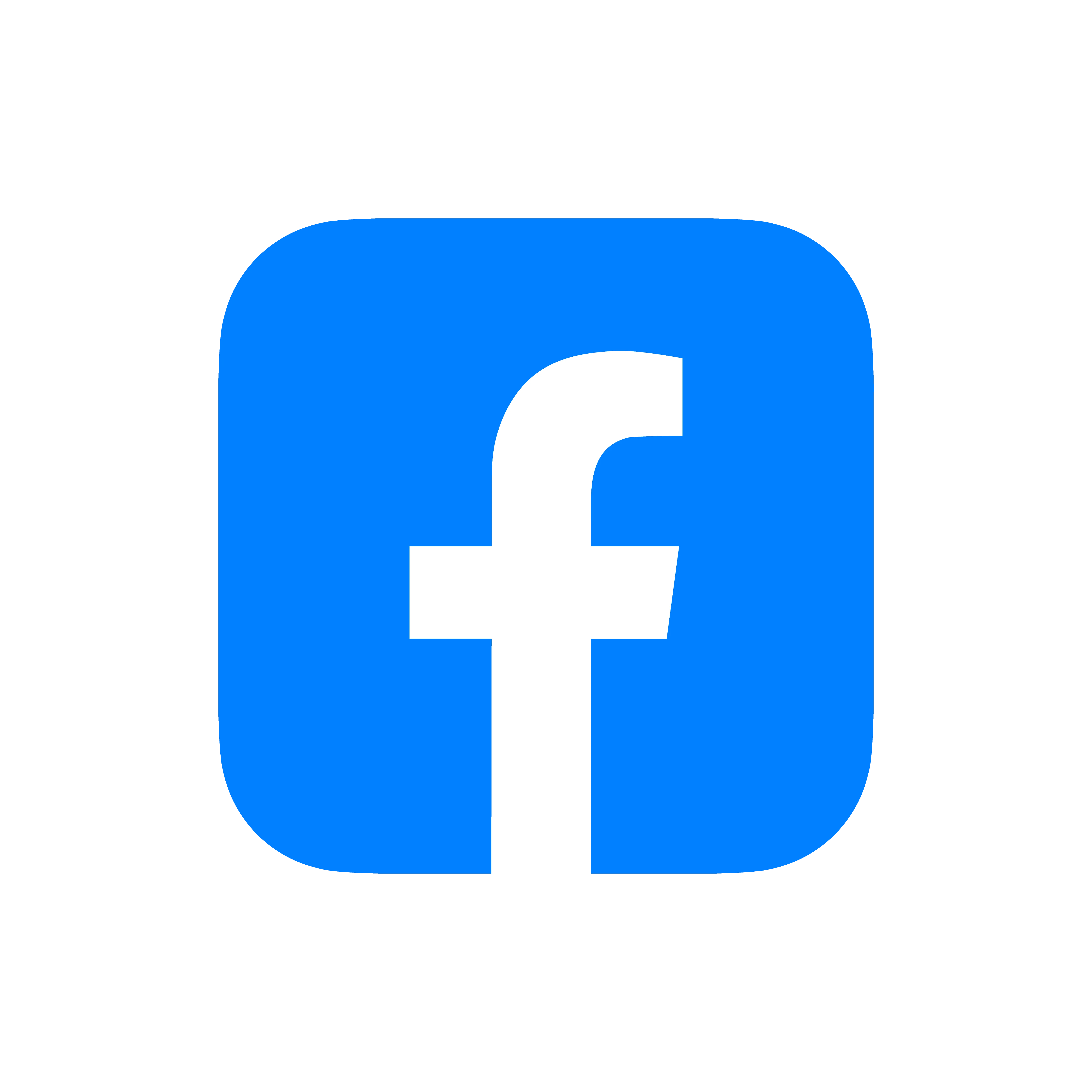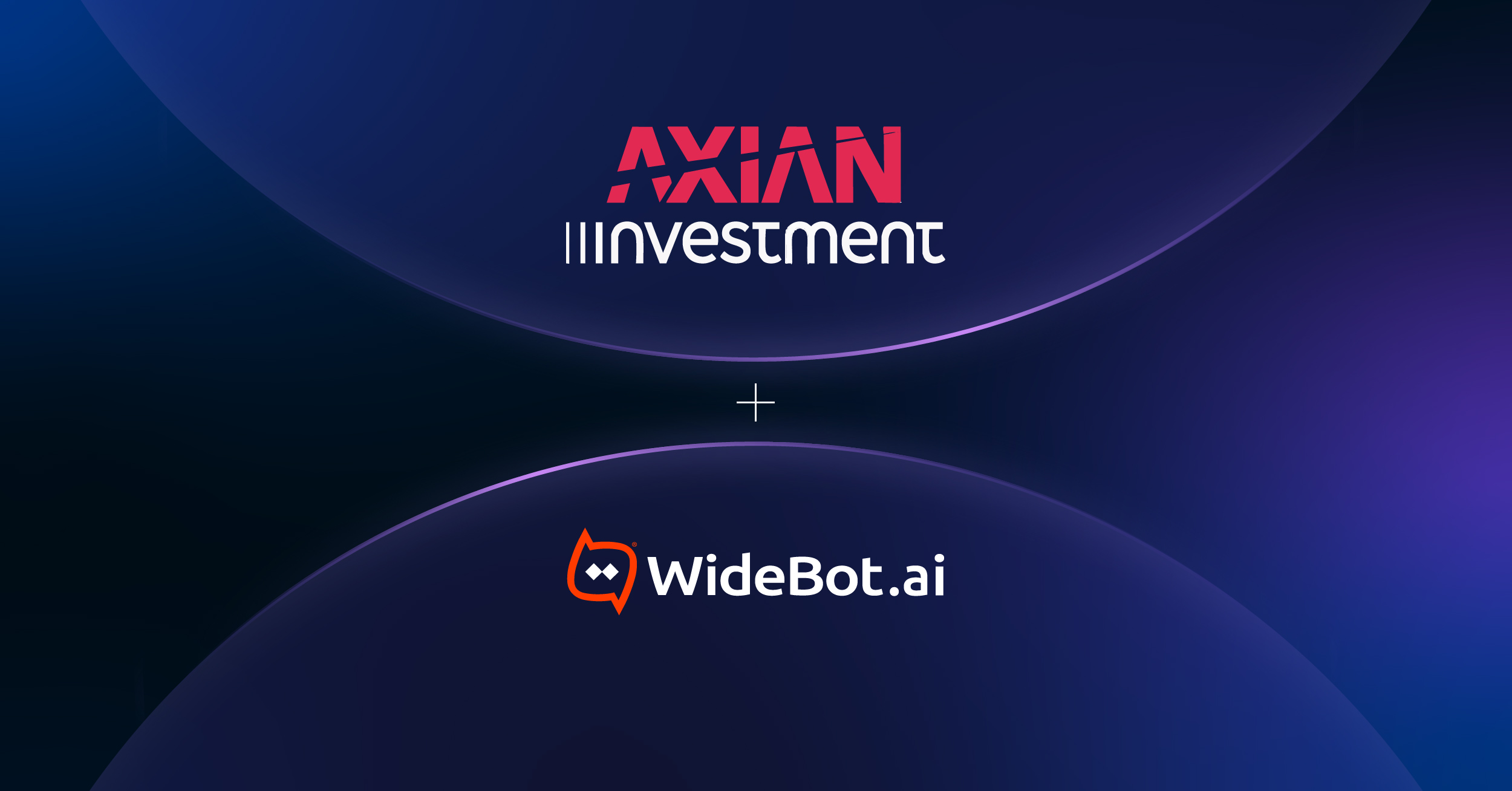Over 250 major healthcare providers and governments around the world are exploring or piloting AI-powered chatbots now to improve communication and patient services. Deloitte reported that automating calls with conversational AI can save a hospital system between $4 million and $12 million annually, demonstrating clear operational and financial impact (Deloitte).
Also, there is research on Simbo.ai that shows:
- AI answering services cut first response times by 37% and problem-solving time by 52%.
- Faster communication like this helps patients feel better about the service. - AI call agents also help lower no-show rates by up to 25%. They send automatic appointment reminders and follow-up calls so patients get clear, on-time messages.
- Practices using AI phone systems report up to a 30% rise in patient sign-ups. This happens because calls are handled well and politely. (simbo.ai)
These statistics aren't just impressive; they're a glimpse into the future. As we enter the second half of this decade, it's clear that chatbots in healthcare are no longer experimental; they're essential. From streamlining appointment booking to assisting in clinical triage, these digital assistants are transforming how healthcare systems operate and how patients engage with care.
In this post, we explore how chatbots are transforming healthcare communication, improving patient experiences, and optimizing workflows for hospitals, clinics, and government health agencies alike.
What Are Chatbots in Healthcare?
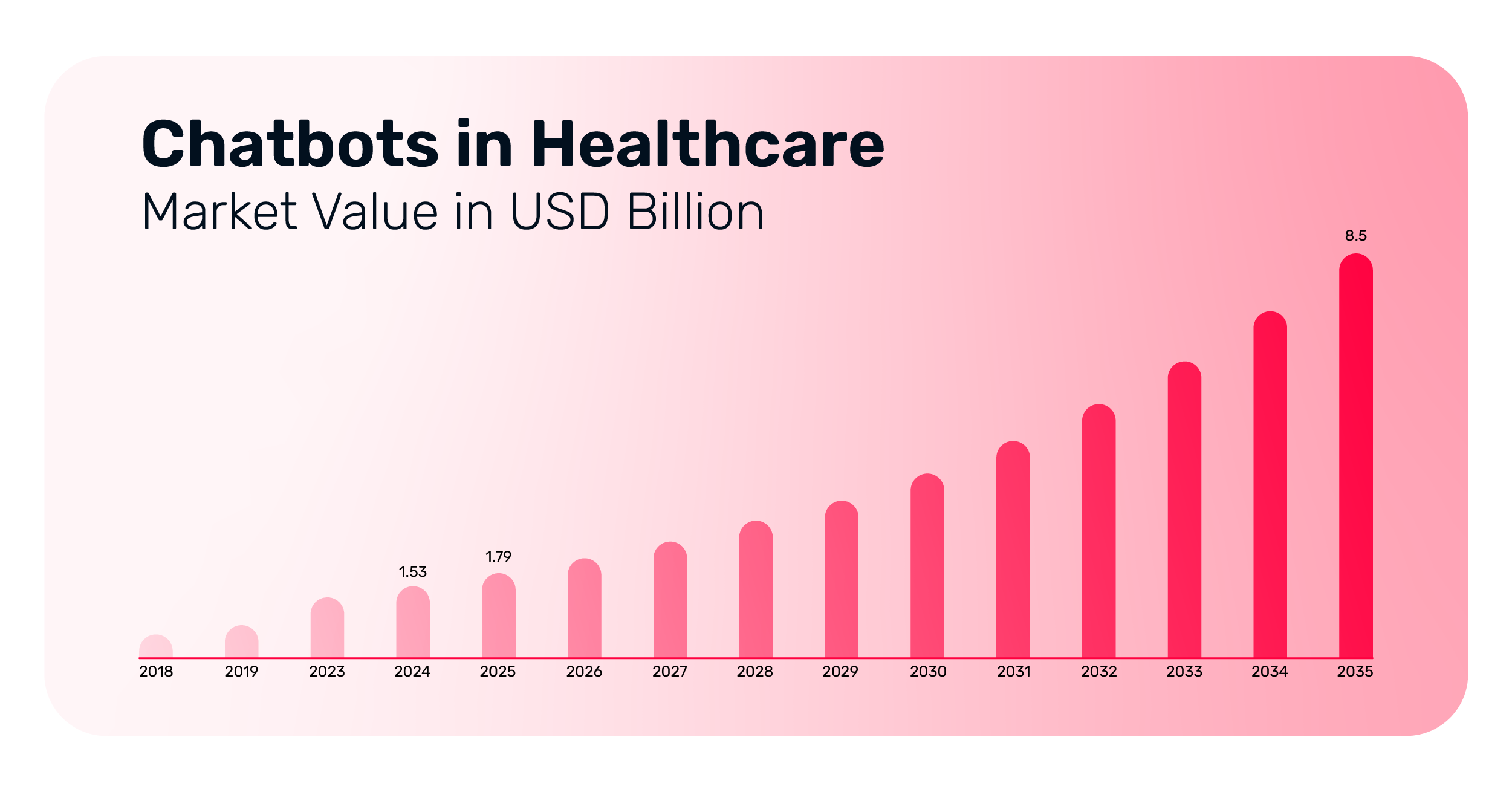
Healthcare chatbots are advanced AI-driven programs that engage users through natural language conversations. They use sophisticated natural language processing (NLP) algorithms to understand and respond to patient inquiries in real time.
Unlike simple scripted bots, modern chatbots in healthcare are built with domain-specific medical knowledge, ensuring they provide accurate, relevant information. They can be integrated with existing healthcare infrastructure such as Electronic Health Records (EHRs), telehealth platforms, and mobile health apps, creating a unified digital ecosystem.
Core functionalities of chatbots in healthcare include:
- Appointment scheduling: patients can book, reschedule, or cancel appointments without human intervention
- Reminders: automated notifications to improve attendance and medication adherence
- Symptom triage: preliminary assessment tools to guide patients toward appropriate care
- Health education: providing reliable information on conditions, medications, and wellness tips
- Data exchange: seamless integration with EHRs to update patient records instantly
Example – Singapore’s “Doctor Covid” Multilingual Chatbots in Healthcare:
Singapore, 24 June 2020 – SingHealth and the Agency for Science, Technology and Research (A*STAR), with support from the Integrated Health Information Systems (IHiS), have co-developed a chatbot known as “Doctor Covid” to improve care for COVID-19 patients at community care facilities. Hosted on the Telegram mobile application, Doctor Covid boasts a variety of features in the patients’ native languages to facilitate effective communication, like vaccination reminders and COVID-19 symptom checks, significantly increasing outreach efficiency and engagement across diverse populations (SingHealth).
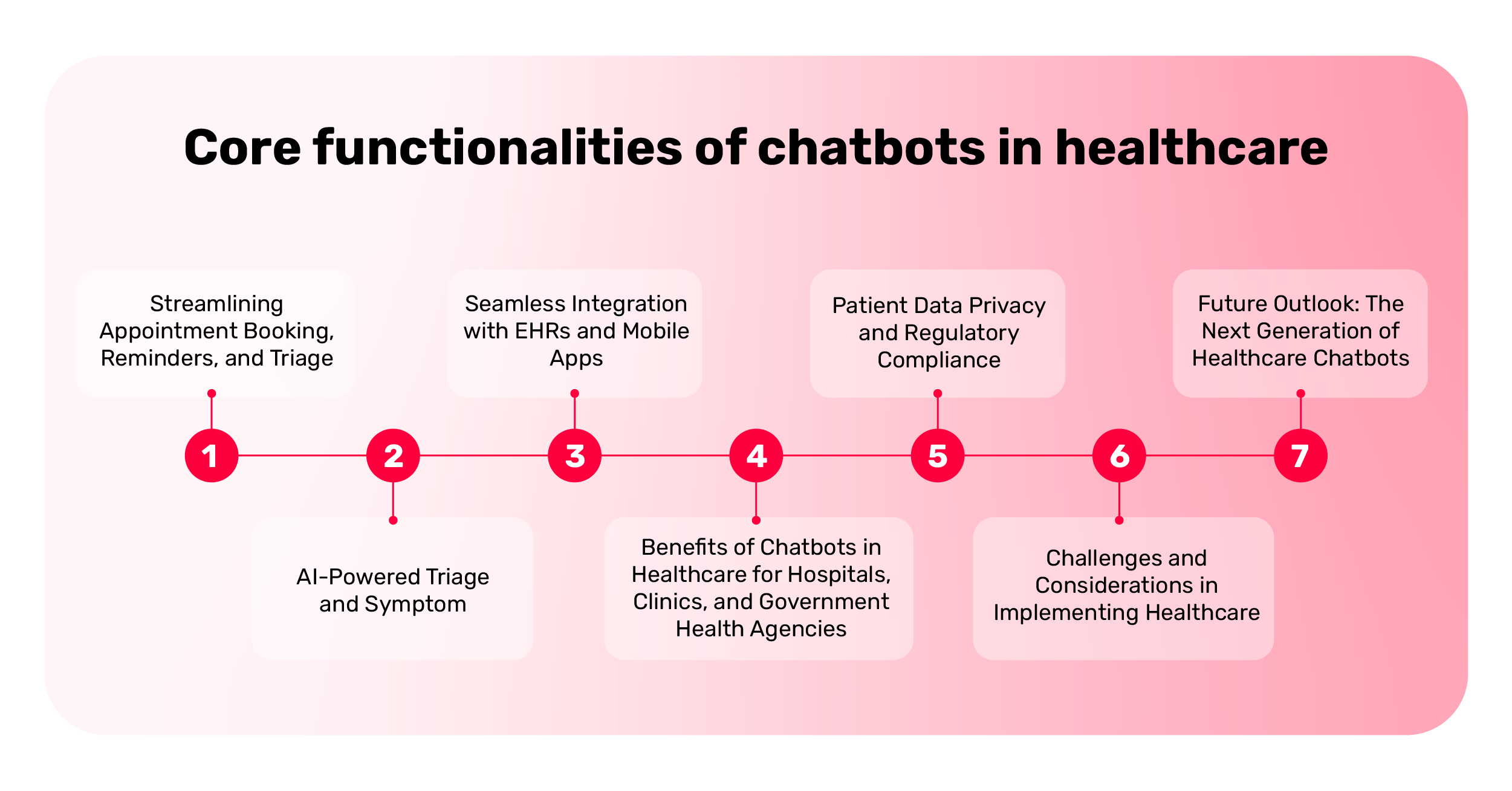
Streamlining Appointment Booking, Reminders, and Triage
One of the most immediate and tangible benefits of healthcare chatbots is automating appointment management. Patients can schedule, reschedule, or cancel appointments via chatbots embedded in hospital websites, mobile apps, or messaging platforms like WhatsApp and Facebook Messenger, eliminating long wait times and reducing administrative burdens.
Example – India’s eSanjeevani Telemedicine Platform:
India’s eSanjeevani platform, a national telemedicine initiative, exemplifies how technology can bridge critical healthcare gaps, particularly between urban specialists and rural patients. Designed to improve doctor-to-patient ratios and expand access in underserved areas, eSanjeevani facilitates both provider-to-provider consultations and remote patient access to care through over 130,000 Ayushman Arogya Mandirs across the country.
While not yet fully chatbot-enabled, the platform demonstrates how digital health systems can lay the groundwork for future integration of AI-driven triage tools and virtual assistants. These could support symptom assessment, streamline appointment scheduling, and enhance patient navigation in remote areas.
By reducing geographic and systemic barriers, eSanjeevani ensures timely, equitable medical interventions at scale. As India continues to evolve its digital health infrastructure, platforms like eSanjeevani offer a blueprint for incorporating AI chatbots into national healthcare systems, promoting inclusivity and efficiency for millions (Microsoft).
Additional benefits:
- Reduced administrative workload: frees up staff for more complex tasks
- Increased accessibility: patients can interact anytime, anywhere
- Higher patient satisfaction: quick responses and easy scheduling improve overall experience
- Data collection: insights from chatbot interactions can inform demand forecasting and resource planning
AI-Powered Triage and Symptom Checking
Preliminary triage is vital to prioritize care and optimize resource utilization. Chatbots now perform symptom assessments by asking patients targeted questions about their condition, duration, severity, and risk factors. These tools help determine whether a patient needs urgent medical attention or can manage symptoms at home.
Cedars‑Sinai Connect (US, Virtual Care Platform)
Cedars‑Sinai Medical Center in Los Angeles launched Cedars‑Sinai Connect (CS Connect) in 2023, developed in partnership with K Health. This AI‑powered virtual care platform automates patient intake, symptom assessment, and preliminary recommendations via a chatbot interface. It integrates patient responses with their medical record and generates a concise summary & suggested treatment pathway, which a physician reviews and adjusts if necessary. Over 42,000 patients used it by mid‑2025. In a published study (April 2025, Annals of Internal Medicine), 77 % of AI‑generated recommendations were rated “optimal” vs. 67 % for physicians—especially in routine recurring UTI cases. Physicians now focus more on care and less on documentation and intake (Business Insider).
Additional benefits:
- Faster initial response: patients get immediate guidance without waiting for a healthcare professional
- Optimized resource use: emergency services are reserved for critical cases
- Empowered patients: knowledge boosts confidence in managing minor ailments at home
- Data insights: anonymized data from triage interactions can inform public health responses
If you want to know more about the capabilities of chatbots in healthcare, you can visit chatbots in healthcare at WideBot AI.
Seamless Integration with EHRs and Mobile Apps of chatbots in healthcare
A key factor in the success of healthcare chatbots is their integration with existing digital infrastructure. When connected with EHRs, chatbots can access and update patient data, providing personalized, context-aware responses.
Use case: Cedars‑Sinai Connect (United States | Hospital Virtual Care Platform)
Cedars‑Sinai Medical Center launched this AI‑powered virtual care chatbot in 2023, developed in partnership with K Health. It is embedded in both their website and mobile app, and critically, integrates deeply with the patient’s EHR, enabling:
- Automatic retrieval of medical history, medications, allergies, lab results, and prior visits.
- Context‑aware intake: the chatbot asks symptom questions, compares responses against the patient’s record, and dynamically tailors follow‑up questions.
- Summarization of patient data and AI‑generated treatment recommendations, which clinicians review and sign off on.
By July 2025, over 42,000 patients had used the system. An Annals study found 77 % of the AI’s treatment suggestions were rated optimal vs. 67 % for physician decisions, particularly in straightforward cases such as UTIs. This integration reduces admin burden and improves clinical efficiency (Business Insider).
Benefits of Chatbots in Healthcare for Hospitals, Clinics, and Government Health Agencies
The deployment of healthcare chatbots (like that of WideBot AI) offers scalable advantages across various organizational types:
Hospitals & Clinics:
- Reduce call center volume, freeing staff for clinical tasks
- Minimize administrative errors and streamline workflows
- Enhance patient satisfaction with immediate support
- Enable personalized pre- and post-visit guidance
Government Health Agencies:
- Manage mass health campaigns, such as vaccination drives and disease prevention programs
- Disseminate accurate, timely public health information during crises
- Improve health access for rural, underserved, and vulnerable populations
- Collect data to inform policy and resource allocation
Patient Data Privacy and Regulatory Compliance
Handling sensitive health information necessitates adherence to strict privacy and security standards. Healthcare chatbots must comply with laws such as HIPAA (U.S.), GDPR (Europe), and local regulations like Saudi Arabia’s PDPL.
Key compliance features:
- End-to-end encryption: securing data in transit and at rest
- Explicit user consent: clear prompts for data collection and sharing
- Role-based access controls: restricting data access to authorized personnel
- Audit trails: tracking data access and modifications for accountability**
Best practices:
- Regular security audits and vulnerability testing
- Partnering with certified, healthcare-compliant chatbot platforms
- Training staff on data privacy protocols
Resource:
HIPAA Journal: Chatbot Compliance Best Practices
Challenges and Considerations in Implementing Healthcare Chatbots
While the benefits are compelling, deploying chatbots in healthcare also involves challenges:
- Data security risks: cyber threats can compromise sensitive health data
- Patient trust: Some users remain skeptical about chatbot reliability
- Integration complexity: Connecting with legacy EHR systems can be technically challenging
- Regulatory hurdles: ensuring compliance across multiple jurisdictions
- Language and accessibility barriers: Catering to diverse populations requires multilingual support and user-friendly interfaces
Overcoming these challenges involves:
- Investing in robust cybersecurity measures
- Building transparency and trust through clear communication about data privacy
- Collaborating with experienced vendors specializing in healthcare AI
- Piloting and iteratively improving chatbot functionalities based on user feedback.
Future Outlook: The Next Generation of Healthcare Chatbots
The evolution of healthcare chatbots is just beginning. Future developments include:
- AI-driven predictive analytics: anticipating patient needs before they arise
- Voice-enabled interfaces: natural language interaction via smart speakers and voice assistants
- Emotion recognition: understanding patient mood to personalize responses
- Advanced multi-language support: breaking language barriers further
- Integration with blockchain: ensuring data integrity and security
Impact on healthcare:
These innovations will make chatbots more intuitive, empathetic, and integrated, leading to more proactive, personalized, and accessible care.
FAQs
1. How can chatbots be used in healthcare?
Chatbots in healthcare can handle appointment booking, send reminders, assist in symptom checking, provide health education, and update Electronic Health Records (EHRs). They also improve patient communication and reduce administrative workload.
2. What is the future of chatbots in healthcare?
The future of healthcare chatbots includes voice-enabled interfaces, emotion-aware responses, predictive analytics, and deeper integration with mobile apps and blockchain systems, making care more proactive, personalized, and accessible.
3. What are the four types of chatbots?
The four main types are:
- Rule-based chatbots – follow pre-set scripts and decision trees
- AI-powered chatbots – use NLP and machine learning to understand and adapt
- Voice-enabled chatbots – interact via spoken language
Hybrid chatbots – combine rule-based logic with AI for better flexibility
4. What is a generative AI chatbot in healthcare?
A generative AI chatbot uses advanced models like GPT to generate natural, dynamic responses. In healthcare, it can simulate human-like dialogue, answer complex questions, and personalize care based on patient data while following medical guidelines.
Conclusion: The Future Is Conversational
In 2025, chatbots in healthcare will no longer be futuristic concepts but vital tools transforming how healthcare organizations communicate, operate, and deliver care. They reduce administrative burdens, improve patient experiences, and enable more efficient resource management, all while maintaining strict privacy standards.
As healthcare providers, government agencies, and digital health leaders embrace these AI solutions, they position themselves at the forefront of a new era, where conversational AI drives smarter, more accessible, and patient-centered healthcare.
Are you ready to lead this transformation?
Book a free demo of our AI-powered healthcare chatbot platform today!
Let’s build a smarter, more responsive healthcare experience together.

